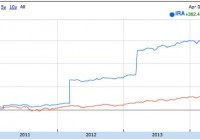How Much More Compelling Is The Southern Company Today?
Recently I provided an update on the Southern Company, suggesting that 5% intermediate-term return expectations might be a reasonable baseline. Since that time, the share price has declined dramatically. This article looks at “how much more compelling” the company is today. On February 4th I published an article regarding the Southern Company’s (NYSE: SO ) fourth quarter and full year earning results. Within this update I indicated that 5% annual total returns over the intermediate-term might serve as a reasonable expectation moving forward. This was based on a growth assumption around 3% coupled with a future earnings multiple around 16 — both of which were in-line with the company’s history. At the time, shares were trading around $51. Today, less than two weeks later, the share price for the Southern Company is closer to $46.50 — a 9% decrease in a very short amount of time. Which naturally brings about a question: “are shares now more compelling? And if so, to what degree?” Barring any extraordinary events, and given that one’s assumptions probably haven’t changed, a lower share price necessitates that the investment proposition has become more attractive. You would still expect the same growth and future valuation as you might have two weeks ago — so a lower price means more value. However, figuring out the quantity by which the value proposal has changed is the important part. It doesn’t really mean much if 5% expected returns turn into 5.1% yearly returns. So let’s work through an illustration to determine a reasonable investment baseline based on today’s price. As indicated in the previous article the Southern Company had adjusted earnings per share of $2.80, while paying out nearly $2.10 in dividends per share. At the time, as is the case now, analysts are expecting growth of just over 3% , which we’ll assume to be an even 3%. That’s 3% growth in earnings alongside 3% growth in the dividends per share. Finally, we’ll use a future earnings multiple of 16 — quite close to the historical mark of the past decades. All of the assumptions stay the same — after all it’s been less than two weeks. What changed is the share price. Here’s a look at what the dividends per share might look over the next five years: 2015 = $2.15 2016 = $2.21 2017 = $2.28 2018 = $2.35 2019 = $2.42 At $51, the “current” dividend represented a 4.1% yield and you might have expected to receive 23% of your original investment back in the form of dividend payments over the next half-decade. With a share price of $46.50, this represents a “current” yield closer to 4.5% along with the expectation of receiving nearly 25% of your initial capital back during the next five years. Already you can see a difference. If earnings were to grow by 3% annually, this would lead to adjusted earnings around $3.25 five years later. A 16 multiple translates to a future price of roughly $52. Incidentally, given an adjusted payout ratio around 75%, this also equates to a future anticipated dividend yield of about 4.7%. As previously mentioned, these assumptions would have lead to expected total returns near 5% (actually 4.6%, but rounded up). With today’s price, this equates to expected annual returns of about 6.4%. In other words, the 9% decrease in share price has increased the baseline expected total return by roughly 1.8% per annum. How much of a difference does that make? Well over a five-year period, investing say $10,000, this would be the difference between an end value of $12,500 versus roughly $13,600, for the higher annual return (the difference is nearly $10,000 over 20 years). The amount of expected dividends and future share price remain, but you can now purchase these same expectations at a lower price. No different than buying milk at the grocery store — the calories and nutrients don’t change, but the price (and thus value received) can fluctuate. Of course you can’t continue to do this analysis everyday. Well, you can — but I can’t write an article on the Southern Company every time the price changes. In lieu of that, I thought it might be useful to provide a range of total return assumptions based on the aforementioned assumptions and a varying share price. $40 = 9.6% annual expected returns $42 = 8.6% $44 = 7.6% $46 = 6.6% $48 = 5.7% $50 = 4.8% $52 = 4% $54 = 3.2% Granted you could have different assumptions for the company. To this point you could adjust the above numbers or else develop “valuation shortcuts” as I have previously demonstrated . The idea is to have a general notion of how the current share price of a security fits in with your underlying expectations. At $50+ you’re basically collecting the dividend payment without much anticipation for capital appreciation — sans a higher earnings multiple in the future. At today’s share price you might expect to receive the 4.5%+ dividend along with slight share price growth over the intermediate term. And once you hit $42 or so, the returns are roughly half dividends and half expected capital gains. As time goes on, with the Southern Company or any one of your contemplated holdings, expectations will change and you can adjust for that. Yet I would contend that your assumptions don’t change all that much (or at all) from day to day. The share price can fluctuate widely, especially in comparison to the longer-tem business results. The best you can do is create a baseline and judge a security in comparison to your alternatives through time. Disclosure: The author is long SO. (More…) The author wrote this article themselves, and it expresses their own opinions. The author is not receiving compensation for it (other than from Seeking Alpha). The author has no business relationship with any company whose stock is mentioned in this article.
